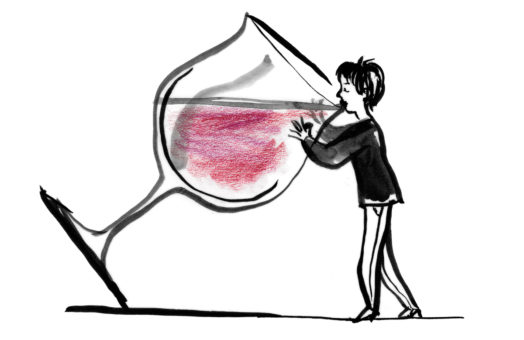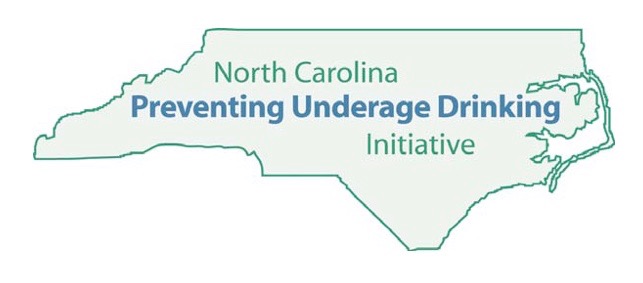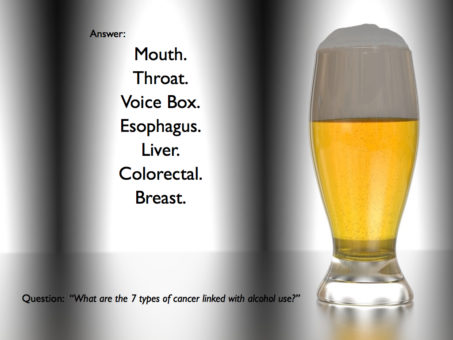Did Drinking Give Me Breast Cancer?
MAY/JUNE 2018 ISSUE of Mother Jones
“The science on the link is clear, but the alcohol industry has worked hard to downplay it.”
Read the full article at Mother Jones.
Did You Know…Alcohol Causes 7 Types of Cancer?
No? Well, you’re not alone.
According to a recent study, only 30% of Americans knew that alcohol use can cause cancer. The damaging effects of drinking can get overlooked in a culture that too often associates alcohol use with a healthy lifestyle. Even though there is a growing body of research that clearly demonstrates the link between alcohol use and at least 7 types of cancer.
This two page information sheet might help answer some of your questions about alcohol and cancer. Including…
- Does alcohol use really cause cancer?
- A couple of drinks won’t increase my risk, right?
- Is alcohol as important as other cancer risk factors?
- Does the type of alcohol I drink matter?
- How exactly does alcohol cause cancer?
- Is red wine really good for my heart?
- What can I do to decrease my cancer risk?
- What is a “standard” drink?
- If I stop drinking, will my cancer risk return to that of a non-drinker?
- What can I do to decrease alcohol-related cancers in my community?
Download the FAQ Sheet
How Alcohol Damages Your DNA
Story at-a-glance
- During a study by the Substance Abuse and Mental Health Services Administration, in the previous 30 days, just over 25 percent of people over 18 reported binge drinking and 7 percent reported heavy alcohol use
- In the short term, alcohol poisoning kills six people every day; alcohol use may also lead to obesity, cardiovascular disease, Type 2 diabetes and seven forms of cancer
- Research demonstrates a product of alcohol metabolism damages DNA and increases your risk for cancers, including cancer of the stomach, pancreas, bowel and breast
- Exercise may help reduce your craving for alcohol, and supplements such as vitamin C, vitamin B, magnesium, milk thistle and N-acetyl cysteine, may reduce the negative effects of drinking small amounts of alcohol
For the full article, visit Articles.Mercola.com
The Unexpected Thing That Happened When I Didn’t Drink for 30 Days
This isn’t a preachy list of the miraculous health benefits of giving up alcohol. I won’t tell you that I sprang out of bed every morning with endless energy, ready to crush my workouts and tackle my to-do lists.
I won’t tell you that I lost weight, saved a bunch of money, or woke up with an instantly clear complexion, radiating an alcohol-free glow.
The truth is, I didn’t experience any major physical changes when I gave up drinking for 30 days in January. But I did learn something huge about myself—something that completely changed the way I view a glass of wine or bottle of beer.
Rosé-Colored Glasses
Why did I want to stop drinking? For one, Dry January is officially a trend in the wellness world, and as a health editor, I was curious. The other big reason: I’d never actually tried not to drink.
I had my first sip of alcohol back in high school (tequila from a friend’s parents’ liquor cabinet, naturally). Since then it’s played a pretty constant role in my life. From casual parties to college fraternity ragers, the ritual of having a few drinks became as ingrained as going to class or out for a run.
Alcohol eased the awkwardness of my freshman year of college, when I knew no one. It helped push me past my inherent shyness to meet new people. I was always into books and school, so drinking was also a way to prove there was more to me than good grades and studying.
Moving to New York City after graduation only strengthened my relationship with booze. The most popular (and convenient) way to socialize is over drinks: Whether it’s a first date, networking meeting, or catching up with a friend, chances are it’ll happen at a bar.
Plus, as the stresses of the “real world” sank in, drinking provided freedom and distraction from my tiny cubicle and shared 500-square-foot apartment. It seemed to be the solution for everything: Bad day at work? Break open a bottle of wine. Feeling lonely? Head to the bar with friends. Rough breakup? Wine to the rescue. Bored? Wine wins again.
In addition to working out, wine had become my escape. And I liked it—a lot. (Apparently, I’m not the only one: A recent study showed that millennials drink an average of 3.1 glasses of wine in one sitting.)
But I don’t believe I ever had a problem. Sure, there were the natural consequences—hangovers, headaches, and regrettable texts—but I never got arrested, injured, or ruined any relationships, so I never really had a reason to stop drinking. So I didn’t—until now.
Sobering Up
As I kicked off Dry January, I wasn’t sure what to expect. The first few days were easy. After a booze-filled holiday season, forgoing drinks for the first week of 2016 was no big deal.
But about a week in, something strange happened. I started to think more. I became more aware of my feelings. I really listened to my thoughts—thoughts that were no longer dulled by drinking.
Unable to pour myself a glass of wine when I got home and let the stress of the day fade away, I reflected more on my life. I thought back on my five years in New York, more than I ever had in the past. I thought about how I missed my family and the sunshine back home in Florida. I thought about my relationships—romantic and platonic, past and present. I thought hard about my job, the progress I’d made in my career, and looming deadlines at work.
Rather than turn to the bottle and push those thoughts aside until the next morning, I actually worked through them. I started reading and writing at night rather than zoning out in front of the TV with a glass of wine. Instead of grabbing drinks with a friend to catch up, we had a sober heart-to-heart over lunch. Instead of splitting a bottle of wine at dinner, my boyfriend and I talked more about our lives and the future.
The time off from alcohol (and the accompanying hangovers) also spurred me to be more productive. I finally started a blog to showcase my photography and writing. I made more healthy meals at home since I wasn’t going out to dinner as often, sharpening my cooking skills in the process. I was generally more creative and thoughtful at work, if not propelled by tons of newfound energy.
Reality Sets In
Then there were some not-so-great consequences. I realized a few hard truths—about friends who weren’t supportive of my alcohol-free month and about the type of person I’d been during some particularly boozy periods of my life. And without the distraction of drinking, I had to contemplate whether I was truly happy living in New York.
In the end I came to view my near-nightly glasses of wine as my own personal soma—the drug imagined in the dystopian novel Brave New World, which provides an instant, pleasurable escape from the stress, worries, and weight of reality.
The thing is, reality is always there—whether you like it or not. I think a lot of us in our 20s turn to alcohol (or drugs or food or exercise) to eclipse our feelings to some extent.
In some ways, that’s OK. I love going out as much as the next 20-something, and I truly believe in the benefits of grabbing drinks with friends at the end of a stressful week. It’s fun going to bars and meeting people you’d never think you had anything in common with—people you may not have met if not for your shared affection for IPAs.
But my monthlong break taught me something even more valuable: If you don’t take the time to sit with yourself, soberly and silently, every so often, you risk losing touch with your true thoughts, passions, desires—and even your fears. And getting to know yourself on this deeper level is one of the most important things you can do.
At the end of the month, I went to a friend’s wedding. I had wine, of course. But I stopped before the sauvignon blanc seeped too deeply into my system. I wanted to remember every magical moment, and I did. There’s no substitute for celebrating marriage with a sip of champagne, but there’s also no substitute for seeing, feeling, and remembering everything clearly, without the haze of alcohol.
Original post credited to Greatist.com
With Heavy Drinking On The Rise, How Much Is Too Much?

Binge-drinking sounds like an all-night bender, but here’s a reality check: Many social drinkers may “binge” without knowing it. Women who drink four or more drinks on an occasion are binge-drinking.
If one glass of wine takes the edge off, why not drink a few more?
This thinking may help explain the findings of a new study that points to an increase in drinking among adults in the U.S., especially women.
“We found that both alcohol use and high-risk drinking, which is sometimes called binge-drinking, increased over time,” says Deborah Hasin, a professor of epidemiology at the Columbia University Medical Center and an author of the study.
To assess drinking trends, researchers conducted face-to-face interviews with thousands of adults. Researchers asked a series of questions, such as: Did you ever drink four or more drinks on an occasion, and if so, how often? The study compares the findings from two surveys. One was carried out in 2001-2002; the other was from 2012-2013.
So what’s behind the increase? The study wasn’t designed to answer this question, but Hasin says there could be a combination of factors.
“Increasing numbers of people feel pessimistic about their economic chances,” she says. So this might help explain the increase in drinking among low-income Americans. As we’ve reported, economists have linked the economy to so-called deaths of despair from causes including opioid overdoses and alcohol abuse.
When it comes to explaining the increase found among women, the way alcohol is marketed may play a role, too. Hasin says she is speculating here, “but just looking at display windows in liquor stores,” they seem designed to appeal to women. “Everything is pink, it’s all rose,” she says.
And beer-makers have sharpened their pitch to female drinkers too, as this Advertising Age article points out. A recent campaign for Coors Light features women competing in races and climbing mountains. “Every climb deserves a refreshing finish,” the ad’s narrator intones.
So if the makers of wine, beer and spirits are enticing us to drink, are some of us ignoring the risks of excessive drinking? Or maybe many women don’t realize when they’re drinking too much?
Not all national surveys have pointed to an increase in drinking. In fact, the National Survey on Drug Use and Health found a slight decline in alcohol use disorders between 2002 and 2013. But even if there’s been no increase, public health experts say excessive alcohol consumption has long been a problem in the U.S.
“Excessive alcohol use is a huge public health problem in the United States,” says physician Bob Brewer, who leads the alcohol program at the National Center for Chronic Disease Prevention and Health Promotion at the Centers for Disease Control and Prevention. The CDC estimates that there are about 88,000 deaths due to excessive alcohol use in the U.S. each year.
“Ninety percent of people in the U.S. who drink to excess are binge-drinking,” Brewer says.
Binge-drinking, to me, always sounds like a term for an all-night bender. But here’s the reality check: It’s easier to “binge” than you might think.
The definition of binge-drinking is “four or more drinks for a woman on an occasion, five or more for a man,” Brewer explains.
So think of an evening out: Perhaps you start with a cocktail, then add beer or wine with dinner. The drinks can add up faster than you think.
“It can be tricky sometimes for people to really keep track of the number of drinks they’re consuming,” Brewer says.
A 5-ounce serving of wine counts as one drink. And a 1.5-ounce shot of spirits (such as vodka, gin, or bourbon) counts as a drink, too. But often, cocktails contain more than one shot. (Exactly what counts as “a drink” is detailed here.)
“A lot of beers now, particularly craft beers, may have higher alcohol content,” Brewer says. “So, if you have a 12-ounce beer that [contains] 9 percent alcohol, you’re really drinking the equivalent of close to two drinks,” Brewer says.
There are tips to help you guard against drinking too much, especially at a festive event or social gathering, such as an office party. One tip: Make a pact with yourself or with somebody else to take a break before each drink. And another: Alternate between glasses of water and alcohol.
Brewer says it’s worth reminding everyone that the U.S. Dietary Guidelines recommend that women limit alcohol to one drink per day, two for men.
Original story credited to NPR.org.

